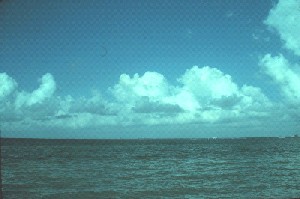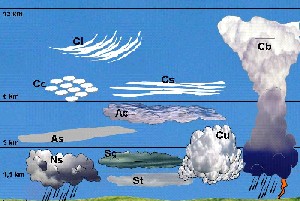
> English > Climate Encyclopaedia > Clouds and Particles > more > 1. What happens in clouds? > * Worksheet 1
|
|
 |
Clouds & Particles
More |
1. What happens in clouds?
Worksheet 1
|
 |
 |
|
1. Image: Microsoft clipart
|
|
 |
Upward movement of warm air containing water vapour starts a series of events. Number the following events successively:
- water droplets fall out of the cloud as rain
- the air becomes saturated
- air rises up
- water droplets collide, join together and grow bigger
- clouds appear
- the air gets colder
- water vapour condenses into water droplets
|
2. Cumulus clouds
In the summertime near the coast, we see cumulus clouds building up over the land during the day, particularly in the afternoon, while the sky above the sea remains cloud-free. How do these cumulus clouds form and what is this process called?
|
 |
 |
 |
|
2. Cumulus clouds building
Photo: NOAA
|
|
3. Rainy parts of your country
Are there areas in your country which are particularly rainy? Why is there so much rain in these locations?
4. Answer individually or in groups
|
 |
 |
|
3. The different clouds in the troposphere. St: stratus, Sc: stratocumulus, Nb: nimbostratus; Ac: altocumulus, As: altostratus; Ci: cirrus, Cs: cirrostratus, Cc: cirrocumulus; Cu: cumulus, Cb: cumulonimbus. Image: J. Gourdeau (click to enlarge, 106 kB)
|
|
 |
Cloud names are derived from Latin and they have the following meanings:
cirrus - curl of hair
stratus - layer
cumulus - heap
nimbus - rain
Look closely at the figure and discuss how the various clouds got their names.
|
About this page:
Authors: Ellen K. Henriksen and Camilla Schreiner - University of Oslo - Norway. Scientific reviewer: Justine Gourdeau - LaMP Clermont ferrand - France - 2004-01-13. Last update: 2004-03-27. |
 > English > Climate Encyclopaedia > Clouds and Particles > more > 1. What happens in clouds? > * Worksheet 1
> English > Climate Encyclopaedia > Clouds and Particles > more > 1. What happens in clouds? > * Worksheet 1


